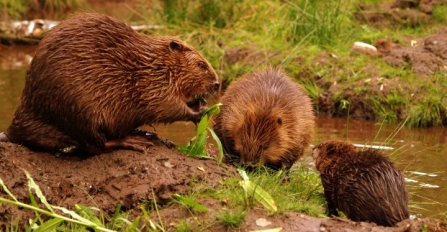The Eurasian Beaver (Castor fiber) was once widespread across Wales but, due to over-hunting by humans for their fur and meat, they became extinct in Wales after the Middle Ages. Until recent decades, the word ‘beaver’ (or ‘afanc’ in Welsh) was mostly associated with the past – you can see references in place names such as Beaver Pool/Llyn-yr-Afanc and in folklore such as the Afanc legends of the of the River Conwy and Llangorse Lake, which tell of fearsome water monsters that devoured swimmers and caused floods. However, times are a-changing, and the beaver/afanc may no longer be an animal confined to myth, legend and history.
Beavers – in the past or future of Wales?
Beaver © Nick Upton/Cornwall Wildlife Trust
Find out more about beavers and read the full survey report here

Beaver family © Jeremy Usher Smith
Unlike the mystical monsters, real beavers are important animals. They play a vital role in enriching biodiversity; restoring and managing wetland ecosystems. Beavers are known as ‘keystone species’ because their activities can benefit a wide range of other animals and plants that live in wetland habitats. Beaver activity can also help to improve water quality, regulate flow, alleviate downstream flooding, stabilise water tables and reduce erosion in rivers. As people like to see beavers, they can also benefit tourism, helping to support local economies.
Beavers have already been successfully reintroduced to over 28 countries in Europe. Here, the Welsh Beaver Project is working to see wild beavers re-established into Wales once again. The Welsh Beaver Project is led by North Wales Wildlife Trust on behalf of the Wildlife Trusts in Wales.

